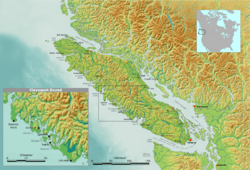Meares Island facts for kids

Aerial view of Opitsaht on Meares Island
|
|

Map of Clayoquot Sound showing the location of Meares Island
|
|
| Geography | |
|---|---|
| Location | Clayoquot Sound |
| Administration | |
| Province | British Columbia |
| Regional District | Alberni-Clayoquot |
| Largest Community | Opitsaht |
Meares Island is a beautiful island located near the village of Tofino in British Columbia, Canada. It was named in 1862 after John Meares. The island is part of the Clayoquot Sound area. It is home to Opitsaht, the main village of the Tla-o-qui-aht First Nations people. Long ago, it was also the site of a short-lived American fur-trading post called Fort Defiance.
Contents
Exploring Meares Island
Meares Island is a popular spot for visitors to Tofino. You can reach the island by boat or water taxi.
The Big Tree Trail
One of the most exciting places to visit on Meares Island is the Big Tree Trail. This special area has a boardwalk that takes you through a forest. Here, you can see some of the tallest trees in British Columbia. It is a fantastic place for taking photos and has been featured in many nature books and TV shows.
Protecting Meares Island
Meares Island became very important in history after 1984. This was when the Nuu-chah-nulth people started to protest. They were worried about a large logging company, MacMillan Bloedel, planning to cut down trees on the island.
The Protest and Blockade
The Nuu-chah-nulth people, with help from environmental groups, set up a blockade. This meant they stopped the logging company from starting their work on the island. Both sides then went to court to solve the problem.
A Landmark Court Decision
The court made an important decision. The Nuu-chah-nulth people had said that Meares Island was part of their traditional territory. The court agreed that until this claim was fully settled, no logging or development could happen on the island. This decision was a big win for the Nuu-chah-nulth. It was the first time in British Columbia's history that a court had stopped the province from making decisions about land claims in this way. This helped protect the island's ancient forests.

